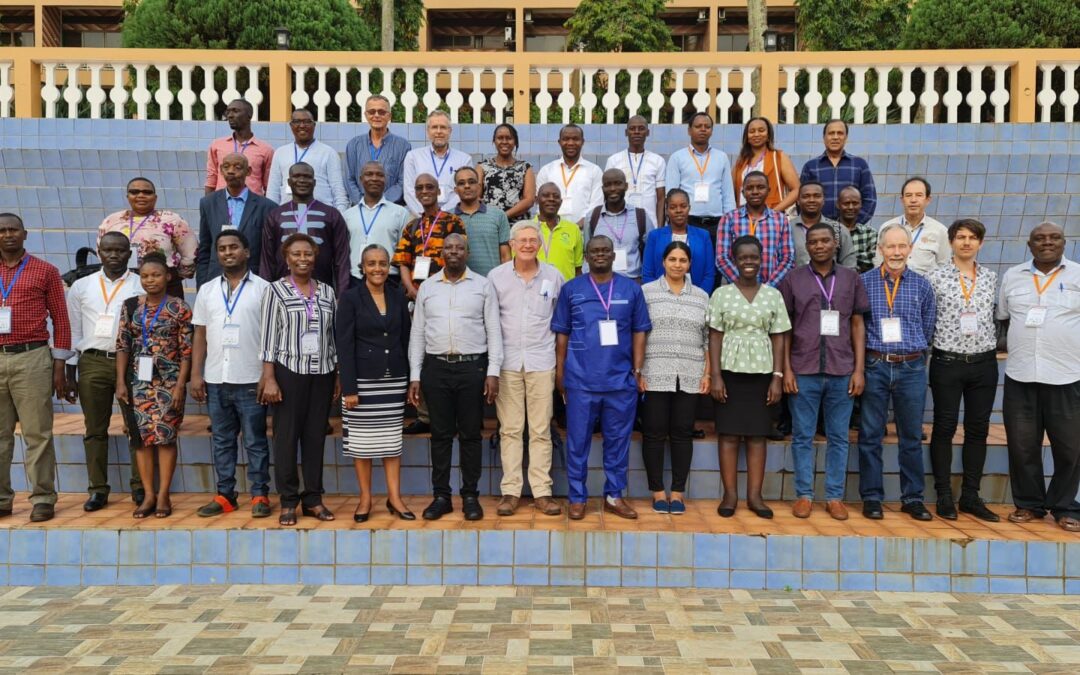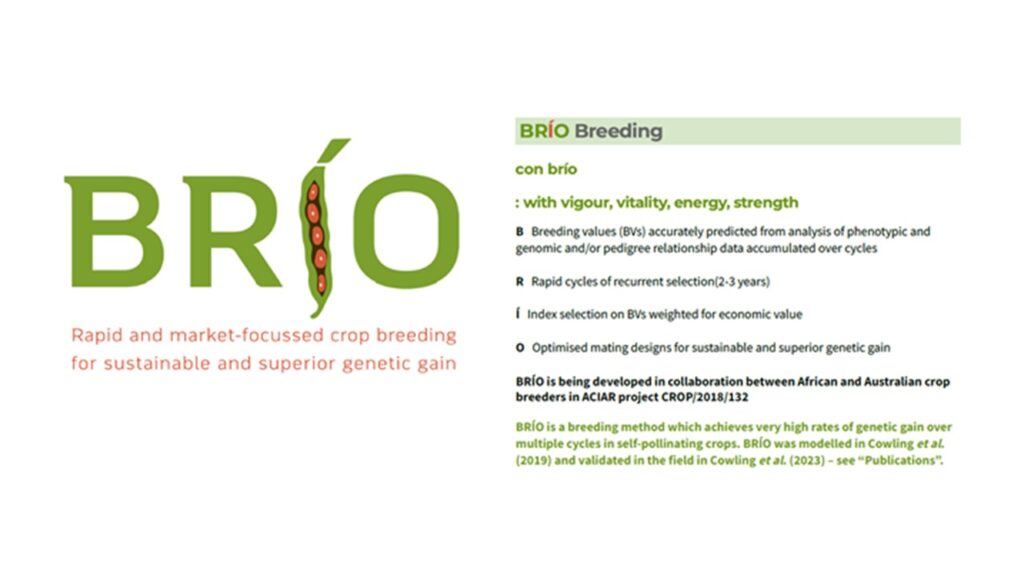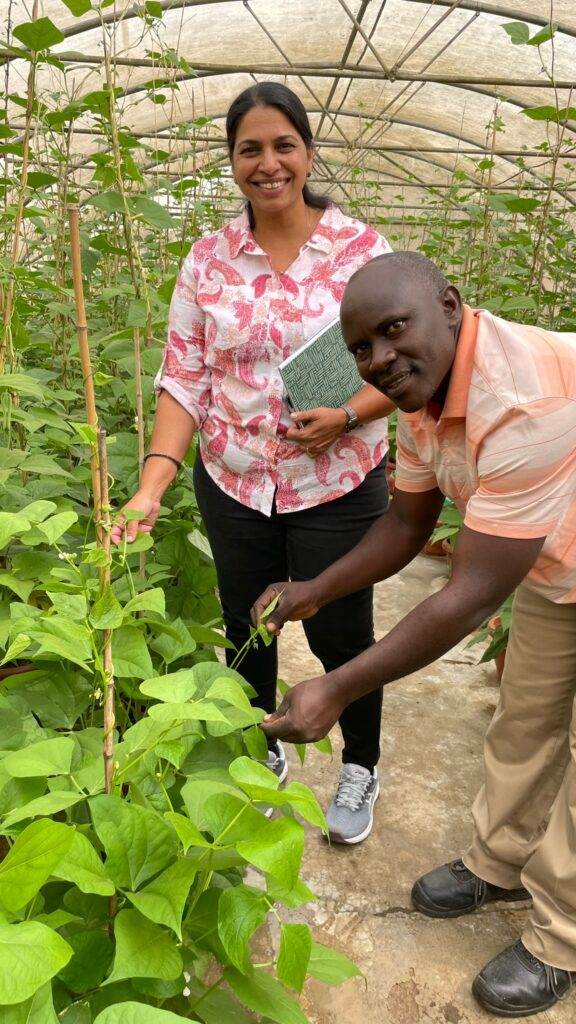by Winnie Nanteza1, Nkalubo Stanley1 Patricia Onyango2, Wallace Cowling3 and Mukankusi Clare2
1National Agricultural Research Organization (NARO)-Uganda
2Alliance Bioversity International and CIAT
3University of Western Australia (UWA)
Bean scientists are adopting a new breeding approach-BRIO to deliver fast cooking and nutritious beans varieties to the Africans. This method was developed by a team of researchers from the (UWA) and Pan Africa Bean Research Alliance (PABRA), with support from the Australian Centre for International Agricultural Research (ACIAR). BRIO offers rapid and long-term gains in breeding, and is based on accurate genomic breeding values, rapid cycles, index selection, and optimized mating designs.
The new breeding method was first integrated into the Alliance-Uganda bean breeding programme in Kawanda in 2019 under the guidance of Dr Clare Mukankusi Mugisha, the Global Breeding lead for common bean at the Alliance of Bioversity International and CIAT, where annual cycles of crossing and selection were conducted for reduced cooking time and higher iron and zinc seed content. Improved lines from the first cycle of crossing have been distributed to bean programs in PABRA’s East Africa members; in Uganda (NaCRRI), Burundi (ISABU), Kenya (KALRO), Rwanda (RAB), Ethiopia (EIAR), and Tanzania (TARI), where they are undergoing field testing and selection for yield, bruchid resistance, disease resistance, drought tolerance and other traits considered important in east Africa. Partners contribute plant performance data to the Breeding Management System (BMS), a central database to inform the crossing decisions of a new cycle. Partners also make selections for advancement into the variety release processes and into new crossing programs in their countries using demand led breeding principles.
Bean researchers made this revelation during the third Annual meeting of the Australian Centre for International Agricultural Research (ACIAR) rapid-cooking bean project (RCBP) held between 20-24 February 2023 in Uganda. The ACIAR-RCBP aims to improve beans for rapid cooking and improved iron and zinc content through annual cycles of pedigree and genomic selection with optimized mating designs based on OCS. The target is to reduce cooking time in common beans by at least 30% and increase Fe content by 15% and Zn by 10% over current varieties during the project. The project links plant breeders from UWA and PABRA members and six partner countries of Burundi, Ethiopia, Kenya, Rwanda, Tanzania, and Uganda in East Africa.
“We’ve made commendable progress in the last 12 months using the new optimal contribution selection (OCS) technique to identify the best parents for crossing for all the partner countries. We are confident that by 2024 we will have reached the targets of reducing cooking time by 30% and increasing iron and zinc in new biofortified beans.” noted Prof Wallace Cowling, the Project Principal Coordinator, UWA. The project is on track to achieve set targets and objectives as it winds up in its final year.
To preserve the skill as knowledge in the region, the project is also building capacity for the future scientists. “We are training young African scientists on how to use this technology in future and by the end of the project, some of the bean varieties will be going out to farmers,” Prof Cowling said.
The meeting combined training on the projects breeding management system, R statistical package for data analysis and DiGGeR tool for trial design at the start of the meeting, followed by a field and industry day and finally a project review session. The meeting included presentations on activities and achievements over the last three years, policy issues on biofortified technologies and scaling, private sector perspectives and enablers such as seed systems and nutrition analysis.
Specifically, the social economists shared key incites on using seed systems to accelerate new bean variety uptake to deliver genetic gains, nutrition, and other benefits to farmers and consumers. Participants learned about the Genetic Innovation Action Area initiatives of the OneCGIAR, including Market intelligence, Accelerated Breeding and SeedEqual. The initiatives target long-term, end-to-end (Full) investment in CGIAR breeding driven by market intelligence, supported by partnerships that deliver genetic gains equitably in farmers’ fields, and accelerating variety turn-over and replacement through a demand led seed system and reaching farmers at the last mile.
During the third year, the project team also explored developing a phenotyping platform for bean nutritional and biophysical parameters. The team-initiated laboratory testing for bean grain starch, protein, and oil content. According to Dr. Ephraim Nuwamanya, a Biochemist at the National Agricultural Crop Resources Research Institute (NaCRRI) Uganda, biochemical tests were concluded in January 2023 with promising results. “The tests revealed that in raw beans, protein content ranged from 20-28%, and starch content ranged between 22-40%,” he reported. He further added that in cooked samples, reductions in general compositional analysis were observed with up to 30% loss in total protein and 33% loss in starch content.
To scale the integration of iron-rich beans in national programs in Uganda, the ACIAR-RCBP through PABRA is collaborating with the Ministry of Agriculture, Animal Industry & Fisheries (MAAIF) and the Ministry of Education and Sports (MoES). The two ministries work to streamline national policy issues enabling biofortification efforts to address malnutrition.
During the Review meeting, Alex Bambona, the Assistant Commissioner-Food and Nutrition Security at MAAIF described Uganda’s progress towards implementing the Comprehensive Africa Agriculture Development Programme (CAADP) and noted that Uganda constituted a Nutrition Coordination Committee and a Technical Working Group to mainstream nutrition sensitive agricultural interventions. He further said that the country is implementing the Uganda Nutrition Action Plan – UNAP (2011-2016, 2020/21 – 24/25), Uganda Food and Nutrition Policy – UFNP (2003), and The Towards Zero Hunger Ten Year Strategy (2020 – 30).
“As part of the Plan, promotion of iron rich beans (IRBs) is the key driver investment of the sector for the last 6 years, covering more than 50 high producing districts,” Mr Bambona said. “4000 demonstration gardens for IRBS and orange fleshed sweet potatoes were set up in 20 districts and over 300 extension workers have been trained in nutrition sensitive agriculture.”
The ACIAR-RCBP activities will contribute to improving children’s nutrition by influencing school feeding programs. While sharing Uganda’s experience in implementing the school feeding program, Susan Oketcho, a Commissioner at MoES reported that the National Development Plan III prioritized the establishment and operationalization of a multi-Sectoral home-grown school feeding initiative. With its 2nd Nutrition Plan, the country has also identified increased access to nutrition services as one of the key strategies for improving nutrition outcomes for school children. However, Oketcho says, Uganda is yet to realize the benefits. “Despite all these policy frameworks, 46.3% of school-going children received meals at schools having improved by 13% points from 34% in 2013/14,” she said.



